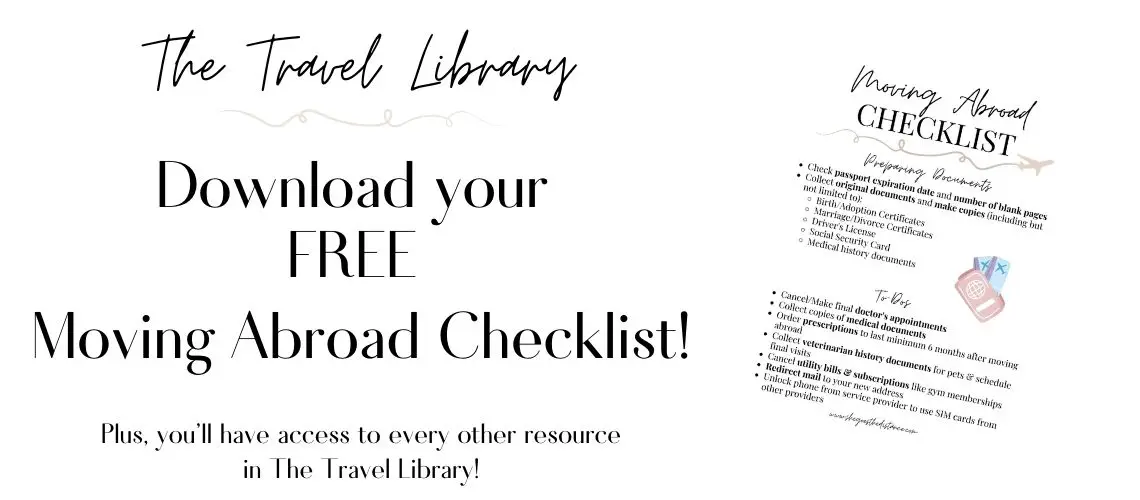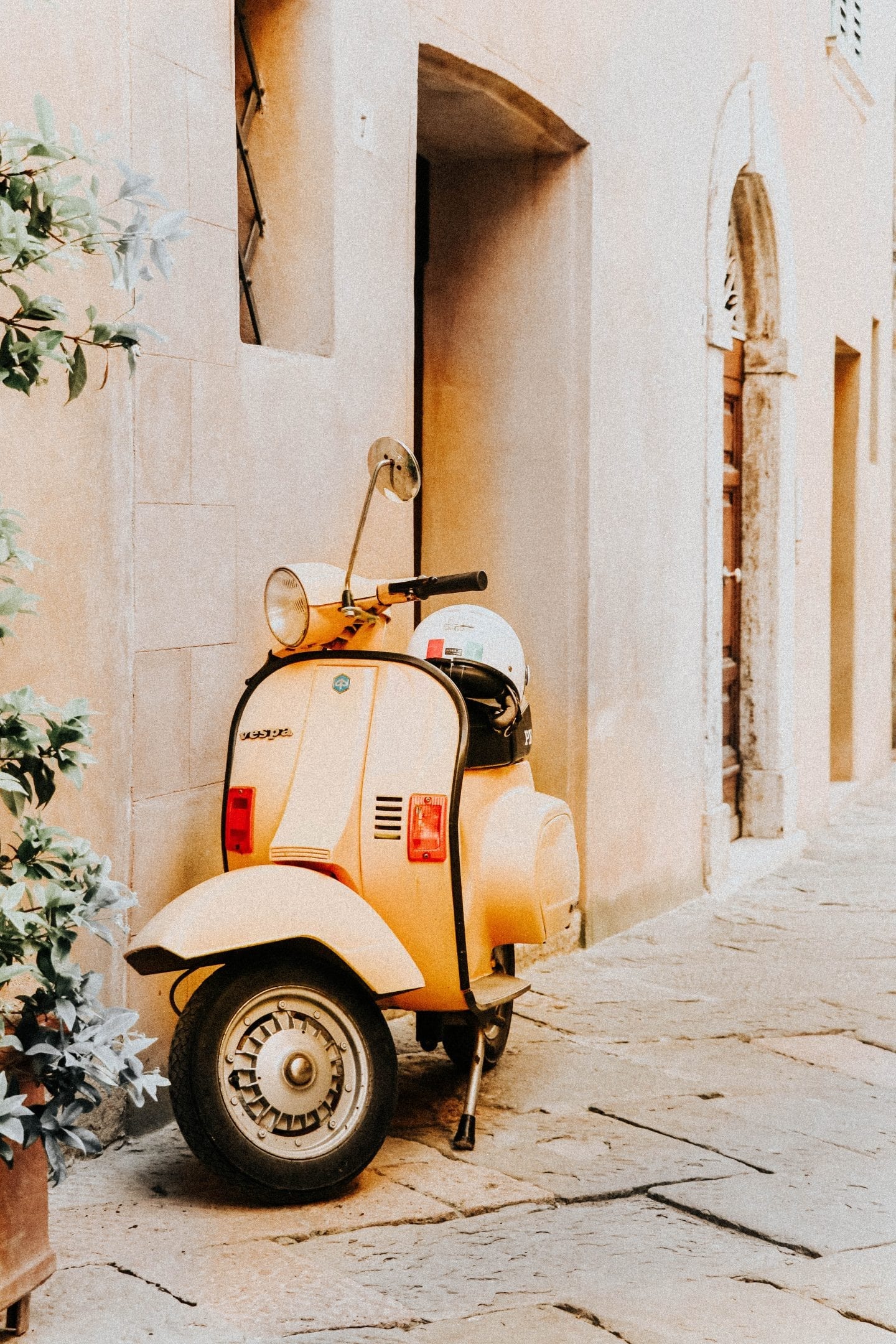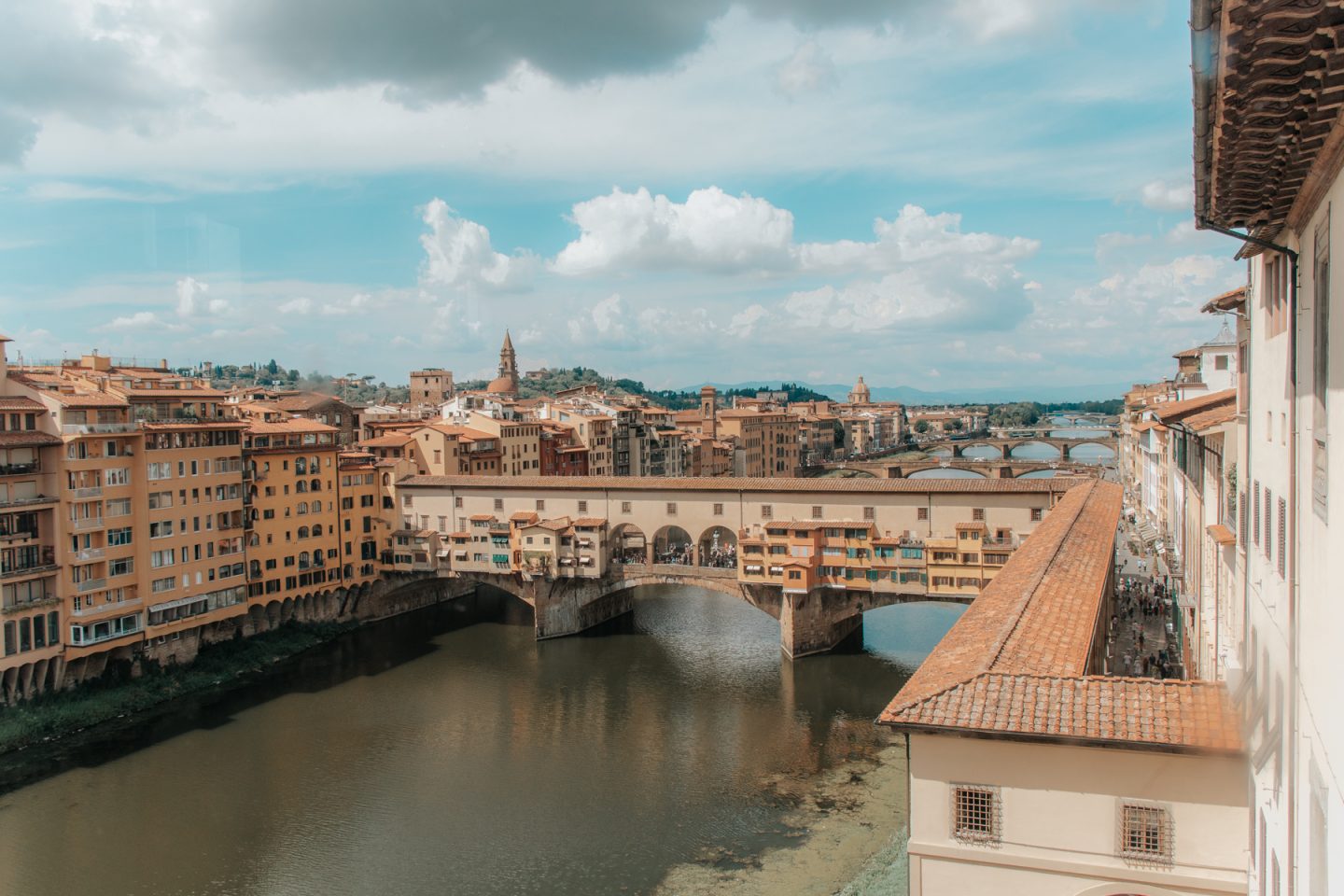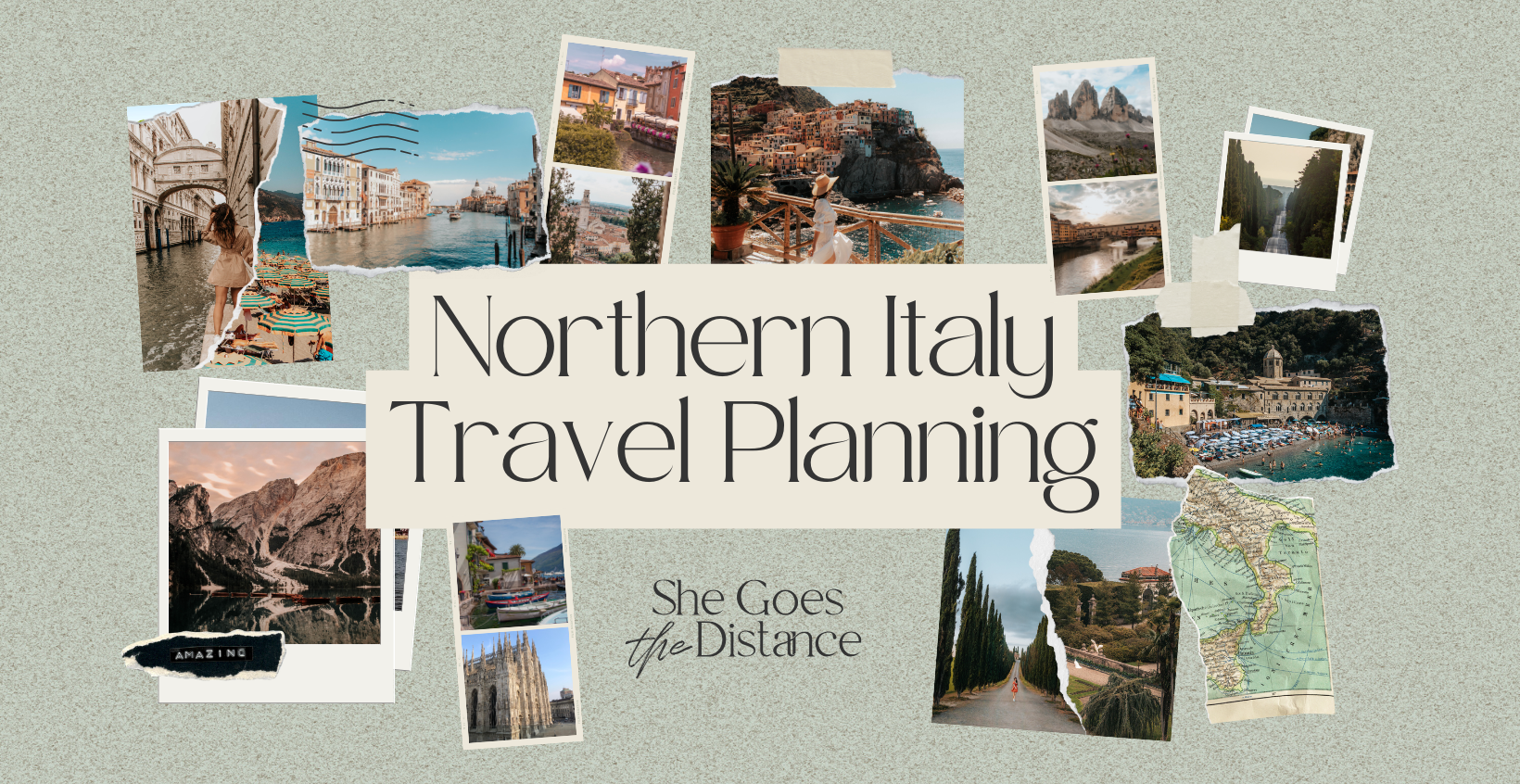
You’ve decided to realize a dream: you want to move to Italy and are determined to make it happen. Whether for a short period of time, a few years of experience abroad or for the rest of your life, there are many different options and factors that go into moving to Italy from the USA.
Visas, tips, must-do processes, cultural adjustments and more: from technical information to emotional considerations, there is a lot that comes with moving abroad. I am currently an expat in Italy – so I’ve lived the pre-moving jitters, frustrations with bureaucratic processes, and post-move challenges.
That’s why in this complete guide I’m not only sharing technical information you must know, but also bits of my personal experience to help you get to Italy and adjust to your new life here.
Some of these links are affiliate links. This means if you make a purchase through that link, I receive a small commission at no extra cost to you. Read my full disclosure!

While we will cover Italy-specific information in this post, there are tons of other things to consider more generally about moving abroad! Before making the international move, download the free moving abroad checklist from The Travel Library to avoid any problems before, during and after your move.
8 Ways You Can Move to Italy from USA

Let’s explore what Italy visa and path to living in Italy could be right for you.
1. Uniform Schengen Visa (Short-term stay)
The easiest and simplest way to “move to Italy” as an American is by utilizing the Uniform Schengen Visa, which allows US citizens to stay in the Schengen Area of Europe for 90 days in a 180 day period.
And United States citizens don’t have to do anything extra to get this type C visa. You just come to Italy, get your passport stamped, and you’re free to roam the country and stay short-term for just about three months.
This means you could temporarily, short-term move to Italy. It’s not really “moving” since you would have to leave after 90 days and stay out of the Schengen Area for 180 days before coming back.
But it is good to know about this for general travel to Italy.
Good to know: The Schengen Area is a visa-free zone made up of 27 countries. Discover the countries included in this list.
2. Employment Visa
Now we are getting into the important visas you want to explore if you are moving to Italy from the USA long term.
The classic type of visa that people think about when moving abroad is a work visa. But it may also be one of the most difficult to get!
That’s because you cannot apply for a visa to go work in Italy. You must have a job offer from a company in Italy that appeals for the Nulla Osta (the security clearance for you to be able to get your work permit).
Italy sets a yearly quota for how many work visas can be sponsored each year called the Decreto Flussi. If they have all been taken up, you can’t use this route to move to Italy that year. In 2023, that number is 82,000 people.
If you do go this route, the visa is valid for 2 years and can be renewed for up to 5 years.
Pro Tip: You must get a visa from your local Italian consulate BEFORE moving to Italy. This can take weeks, so start the process according to your timeline.
3. Self-employed Visa
Italy has two types of self-employed visas that allow you to work yourself and call Italy home:
- Start-up visa: you’re going to open a company in Italy or fill an executive role in an existing company
- Freelancer visa (aka digital nomad visa): you’re going to work as a freelancer
These sound great, but they are difficult to obtain. The first challenge is that very few are available, as Italy puts a maximum allowance on how many of these types of visas can be given out yearly.
The second challenge is that to apply for this visa, you will also have to obtain the Nulla Osta clearance before applying for your visa. But because you are not an Italian company, you’ll have to contact and hire an immigration agency in Italy to do it for you.
So this visa also becomes expensive.
4. Student Visa
If you are interested in going to an Italian university, you can apply for a student visa.
You can apply at your local US Consulate for the visa as soon as you receive your acceptance letter. You must show proof of health insurance, that you have sufficient financial means to support yourself and where will be your place of residence.
5. Elective Visa
Are you moving to Italy from the USA to retire? And/or do you have passive income? Then you may want to apply for an elective residence visa.
The elective visa allows you to move to Italy but the catch is that you cannot work in Italy on this visa. That is why it is usually used by retirees or people who make a sufficient enough passive income to sustain themselves.
You will have to show concrete documentation and evidence of your financial situation.
6. Investor Visa
For those that fall into a category of being high net-worth, there is the option of the Investor Visa.
You must invest in one of these things to apply for this visa:
- €250,000 in an innovative start-up
- €500,000 in a limited company
- €2,000,000 in government bonds
- make a €1,000,000 philanthropic donation
It’s definitely not the most reasonable or attainable of visas based on its requirements, but it is an option.
7. Dual Citizenship Jure Sanguinis
The way I decided to move abroad was through applying for my dual citizenship in Italy through the jure sanguinis process, or through ancestry.
Obviously, this option applies to those who are of Italian descent and whose ancestry meets all the requirements for having retained their right to Italian citizenship, which you can find in my article dedicated to applying for dual citizenship in italy.
From collecting dual citizenship documents from the local vital statistics bureau in the USA and relevant town governments in Italy to going through a sometimes tiring process with the local Italian comune, or town government, this route can be one of the most time-consuming for moving to Italy.
But, if everything is done correctly, you earn your Italian citizenship and therefore the option to live in Italy, work in Italy and come and go as often as you’d like, in addition to the benefit of being an EU citizen and allowing you easy travel throughout the EU.
8. Various Government Initiatives (€1 euro houses, towns paying you to move there, explained)
I’m sure you have heard about the famous €1 euro houses in Italy. Local Italian governments have also ideated their own initiatives to spark population increase, including paying people to move there.
You can peruse the list of €1 euro houses in Italy available but keep in mind that you won’t be spending just a single euro to move here. The initiative comes with the stipulations that you will invest in the real estate property to renovate it and there is a specific amount of time you have to stay in it before you can sell it.
There are also various towns and regions willing to pay people to move there, again usually with contingencies like fixing up the property or opening a business. You can check out some offering this in early 2022, but new initiatives can pop up at any moment.
The Cost of Moving to Italy from USA
Domestic vs. international moving costs can look very different!
While moving abroad, you’ll likely have to cut down on a lot of material items. You may decide to sell all your current furniture and large items and just buy them while in Italy, or hire an international moving company to move your big items abroad for you.
Here are some of the main costs you’ll have to consider moving to Italy from the USA:
- Flight to Italy and luggage
- Visa fees
- Hiring help to get a visa (optional)
- International Moving Company (optional)
- Cost of moving pets (optional)
- Potential apartment or house down payment
- International Driver’s Permit/License for driving in Italy
Pro Tip: Before moving abroad, focus on building up your savings so that you have a cushion to fall back on in case of emergencies.
Cost of Living in Italy
In a post I wrote about Living in Bergamo for the Expatolife blog, I go into detail about the cost of living in my city. But I’ve only put cost of living as a subsection in this post because it varies so much based on where you move to in Italy.
The biggest factor is north or south Italy. Then the costs vary even more if you desire living in the city or are content living in a smaller, more remote town.
In general, the cost of living in Italy compared to the United States is much lower. But, incomes in Italy are also lower.
To get a better idea about the cost of living in Italy, check out Numbeo’s cost of living comparison tool to get an idea of the difference between the USA and Italy.
The Best Places to Live in Italy as an Expat

I’m going to keep this section short and sweet to later dedicate an article to the topic.
As a brief overview, the reality is that you will have your own wants and needs when you’re moving to Italy from the USA.
And the other part of the reality is that Italy is so geographically diverse that it is hard for me to say that one place is better than another.
As a new expat moving to Italy, you may find comfort in more international locations like Milan and Rome. Florence, Genoa and Bologna are good for someone wanting a smaller city. Or you may want to move to a rural area, like a Siena or a Perugia.
The north of Italy is generally more industrious, better for jobs and a higher standard of living. The south of Italy is beautiful and less expensive to live in, but it is rural in most areas and finding a job may be more difficult.
But there are way more nuances to Italy, to its regions, to its towns and cities. So if you have personal questions about a place you are thinking about living, share them with me in a comment and I can give you my thoughts on it!
What to Do Before Moving to Italy from USA
Check and Make Copies of Important Documents
It’s important to always have and keep track of your vital records. Make copies of birth certificates, marriage certificates, passports, etc.
And before booking your flight to move, check the expiration date of your passport. number of pages in your
Pro Tip: Keep all these documents in a closed folder and always bring them along with you in your personal item or carry-on suitcase when flying internationally.
Close Bank Accounts
Whether or not you choose to close your American bank account may depend on your future plans. If you know for sure that you will never move back to America, you can close it.
I personally still have my American bank account because I plan to move back at some point and I still have other affairs in America like online school and investments.
Alert Providers (utilities, phone service, Internet)
Once you move abroad, you don’t want to have to still be tying up loose ends from the US!
As soon as you know your moving date, advise any providers to which you pay bills so that you don’t continue to pay for services you aren’t using.
Prescriptions/Doctor’s Visits
You should schedule any important doctor’s visits before moving abroad. This way, you won’t fall behind or have to worry about not getting an appointment once you arrive in Italy.
You will need some time to get your healthcare ID and get settled, so get important doctor’s visits done before the move.
This also goes for prescriptions. If you can, you may want to ask for more months’ supplies of any prescriptions you take to cover the beginning period of moving abroad.
You won’t immediately know who your doctors will be or if you can get quick appointments with them, so it is better to play it safe by having your medication supply cover you for more time than usual.
Packing
Packing to move to Italy could be its own article! But there are important things to note about what to pack and how to pack to move abroad and specifically to move to Italy.
The first thing to keep in mind is how many suitcases you want to travel with. This, of course, depends on a lot of factors and your personal moving situation.
The things you should surely pack are your important documents and a universal plug adapter (Italy uses plug types C and F) so that you can use your electronics once you arrive.
What to Do Immediately After Moving to Italy from the USA

Alert the Questura
If you are a non-EU citizen and intend to stay in Italy longer than 90 days, you must alert the local police within 8 days of your arrival in Italy.
You must fill out the “Dichiarazione di Presenza” to alert the Questura, local police station, if you are entering Italy from the Schengen area. If you enter Italy from another Schengen country, even as a US citizen, you will fill this out.
If you enter Italy directly from the United States, therefore you have the stamp in your passport of your entry, then you do not need to fill out the Dichiarazione di Presenza and give it to the questura.
The law allows you to show only the stamp on your passport as proof of the date you entered Italy. Include a copy of your passport (both the identification page and the page with your stamp on it) later in your residency application.
Apply for Codice Fiscale
A Codice Fiscale is your tax code number, kind of like a Social Security Number, but it is not private.
It is essential to accessing many fundamental instruments of daily life, from being able to open a bank account in Italy to accessing the public healthcare system.
You will fill out this form for the Agenzia dell’Entrate AA4/8. Then, you’ll send it to the Agenzia dell’Entrate of your province.
Register your residency with the Comune & apply for your permesso di soggiorno
If you are staying in Italy for over 90 days, you will have to register as a resident at the local Comune, or town government.
You will fill out paperwork to establish residency to give to the comune. The application for residency can usually be found on your comune’s website or you can request it from the office.
Then once your residency is confirmed, you will apply for your permit to stay, of where there are two types:
- Permesso di soggiorno
- Carta di soggiorno
The permesso di soggiorno is a temporary resident permit.
Good to know: You can apply for Italian citizenship after living in Italy for a consecutive 10 years on a permesso di soggiorno.
The carta di soggiorno can be applied for after 5 years of living in Italy with the permesso di soggiorno, allowing you benefits to live and work in the EU like an Italian citizen. You can apply for your Italian citizenship after living in Italy for 5 years with this permit.
You apply for these permits at the local post office by filling out a “yellow kit” (they will know what you are talking about!) Read more about this process in my article about dual citizenship in Italy.
Apply for your Tessera Sanitaria
One of the biggest concerns for people moving abroad is usually expat health insurance.
While living in Italy as an expat, you can choose to have either private health insurance or take part in the public healthcare system.
Italy’s public healthcare system is very good and essentially included in the taxes you pay.
To enter the public healthcare system, you must apply through your local ASL, or health authority. You will ask them the fee and pay through the post office.
Keep the payment receipt, bringing it with you along with these things to the ASL:
- Passport
- Valid permit of stay or receipt of application
- Valid Codice Fiscale
- Proof or self-declaration of address
You will then receive a receipt and/or temporary card to use in the meantime. Hold on to these until your official tessera sanitaria arrives in the mail.
Practical Information for New Expats in Italy
Know Your Nearest US Embassy & Emergency Numbers
As a US national living abroad, it is always important to know and store the contact information of the nearest US embassy. You may have to use their services for any bureaucratic matters like notarizing documents to be used in the US or visa issues.
Hopefully it never happens, but in the case of an emergency, the number to call in Italy is 112.
Pro Tip: Sign up for the STEP Traveler program to receive updates about events and national security issues from the local US embassy.
Take advantage of tax breaks for expats
Taxes in Italy are quite high, but one thing that you won’t have to worry about as United States citizen living in Italy is getting double-taxed. There is an agreement between the two countries that prevents you from getting taxed twice on the same income.
I’m no professional, so I recommend consulting your local “commercialista”, or accountant, in Italy and researching resources online like this overview of taxes for American expats in Italy.
Getting a new phone provider
One of the first things you will probably want to do when you move is have a working phone! So you’ll have to get set up with a local provider.
Getting a SIM card in Italy is the best route for using your phone both short-term and long-term in the country. A cell phone plan is typically very affordable. I personally only pay €7 per month.
Top providers are TIM, Vodaphone, Iliad, WindTre, Fastweb and Ho mobile.
Start learning the Italian language
Besides the big cities, you will not hear many Italians speaking English on the regular.
English is taught all throughout school, but even the younger generation isn’t used to speaking it on a daily basis and so it becomes imperative that you learn Italian.
This is not only an integral part of what you should do anyway as an expat living in a new country, but essential if you want to get a job in Italy.
Mother-tongue English is certainly a desirable quality that employers want, but rarely will you find a company in Italy that works only in English.
The best way to learn Italian is to practice speaking it every single day. Of course if you are starting from nothing, you should begin with structured learning courses.
Making friends as a New Expat in Italy
Living in Italy as an expat is always an adventure, with lots of highs and lows while you are adjusting to your new life.
Finding friends and making connections is one of those things that can make the adjustment less hard.
But it is not always easy! There are some places in Italy, like Rome and Milan, that have huge expat cultures and are very metropolitan. So meeting people is a naturally easier effort in these cities.
In many places though, the culture of friends is not as open as you could say the US is. People have strong ties to their friend groups and when they go out, they tend to all stick together.
Of course, there are times where you can strike up conversations and meet people at bars and cafés.
But I also recommend the following as tactics for making new friends after moving to Italy.
Facebook Groups
It may be the most forced of the friend-making efforts, but joining Facebook Groups with fellow expats in Italy or in your same city at least gives you an instant common denominator on which to build friendships.
People have joined those groups for the same reason as you – to meet people living in the area. So it is a good place to start.
They are also a great resource for finding out about local events and gatherings.
Local Markets
Rather than a café, where most people drink their espresso and then go on their way, try to head out to a local market.
You can much more easily strike up conversation with the local vendors and market visitors than you can with someone minding their own business at the coffee bar.
It’s also the best way to start getting to know your local culture, which is huge in Italy. The different regions and even provinces of Italy all have their own traditions, foods, events, even languages!
Through Work
The easiest way I made friends in Italy was through getting a job. My colleagues have become some of my closest friends.
It was extremely difficult at first to integrate myself because my knowledge of the language wasn’t yet sufficient, but having a group to which you belong and not having to go it by yourself seeking out groups to join makes a huge difference when making friends in Italy.
Comune Events
One of the other possibilities to make friends with the locals is through events happening through the Comune (the local town government.)
For example, there are a ton of different festivals, particularly throughout the summer in Italy, at which the entire community gets together to eat the local foods, listen to music and have fun.
Final Thoughts
Moving to Italy from the USA is one of the scariest, biggest decisions you could make in your life. We tend to romanticize Italy, from its food to its people, from its culture to its places.
And while Italy is an amazing place to experience, don’t forget that you will not be on vacation. You will be living in Italy, so you will still face the ups and downs of everyday life.
Sometimes it won’t be so glamourous. Many times you will pinch yourself.
Sometimes adapting to different aspects of the culture will be difficult and maybe some aspects you will never get used to or like at all. Other parts will make you fall deeply in love with your life in Italy.
I wrote this practical guide so that you are armed with the information to make your dream life come true.
But just know that only YOU have the power to focus on the beautiful and positive in starting this new chapter of your life! And I will always be here as your friend and resource.
So, what is the biggest challenge you are currently facing in moving to Italy from the USA? Let me know in the comments so I can give you personal help!
Share this guide to Pinterest if you found it helpful!


I hope this article has been insightful and useful to you in your decision process of moving to Italy from the USA!
XOXO
Michela




Can you tell me how long from the time you submitted your application to the Italian Consulate until you received your Visa was? We applied for our Visa 6 weeks ago and haven’t heard anything yet. We applied for an Elective Resident Visa (retirement) but haven’t heard anything …
Thanks in advance.
Author
Hi Pat! Thanks for reading. I actually moved to Italy by getting dual citizenship, so I am not as familiar with the process of the Elective Resident Visa. I also went through the Italy town hall to move here rather than the consulate, so I’m not sure about the consulate wait times, but I know it can take months to years for approvals for the dual citizenship process through the consulate, so I wouldn’t be surprised if it takes several months to hear back also for this visa type. Sorry I couldn’t be of more help!